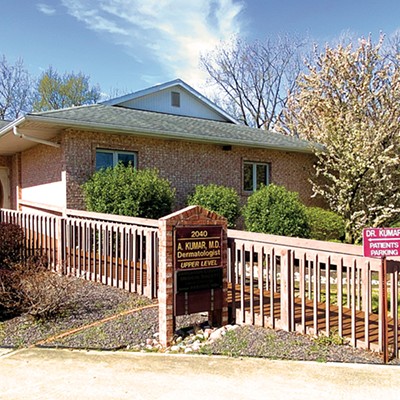Illinois launches Health Information Exchange
New electronic health records network supported by federal funds
[
{
"name": "Air - MedRect Combo - Inline Content 1",
"component": "11490391",
"insertPoint": "3",
"requiredCountToDisplay": "1",
"parentWrapperClass": "fdn-ads-inline-content-block"
},{
"name": "Air - MedRect Combo - Inline Content 2",
"component": "11490392",
"insertPoint": "7",
"requiredCountToDisplay": "5",
"parentWrapperClass": "fdn-ads-inline-content-block"
},{
"name": "Air - MedRect Combo - Inline Content 3",
"component": "11490393",
"insertPoint": "12",
"requiredCountToDisplay": "9",
"parentWrapperClass": "fdn-ads-inline-content-block"
}
]
Electronic health records aren’t just the latest fad — they’re the driving force behind much-needed improvements in patient care.
The technology puts physicians and their patients on the same page, says Laura Zaremba, deputy director for the Illinois Department of Healthcare and Family Services. Instead of sifting through paper charts, physicians can access their patients’ complete medical records on one computer screen. Patients can also electronically access their prescription and treatment history, test results and doctor recommendations.
“As providers continue to adopt electronic health records, it increases their ability to provide access to their patients for these records,” Zaremba says. “It’s particularly helpful for parents who have children, by keeping track of appointments, tests and immunizations, or for people who are caring for elderly adults and need a lot of medication management.”
Electronic health records will not only improve communication between physicians and their patients, but also between the state’s primary care physicians and hospitals.
Illinois recently received $18.8 million from the United States Department of Health and Human Services for its Health Information Exchange, a new statewide network that allows health care providers to share electronic health information. Zaremba, as the head of the newly created Illinois Office of Health Information Technology, will oversee the HIE’s development.
In addition to Illinois, 40 other states received a portion of the $386 million authorized through the American Recovery and Reinvestment Act of 2009 to develop HIE networks. The federal bill calls for the creation of a $20 billion national electronic health records network by 2014.
Assistant Senate Majority Leader Dick Durbin, D-Ill., recently issued a statement in support of the HIE program. He said: “Because they can be shared instantaneously with multiple doctors and can be transmitted hundreds of miles in seconds, electronic health records are an effective tool for improving the quality of health care and saving lives.”
Illinois began planning for electronic health records in August 2005 with the creation of a special task force comprised of health care stakeholders. In December 2005, these members issued a final report calling for legislation to create a state HIE. After their recommendations were ignored, the taskforce reconvened as the Illinois HIE Advisory Committee in January 2008.
In February 2009, Quinn authorized a $3 million planning grant program that helped health care providers implement electronic health records on a local level. The program’s goal was to then link up local networks to create the state’s HIE network.
“We’re really just embarking on the statewide efforts here,” Zaremba says. “It’s going to be a multi-year process, and we’re constantly adding to the community of stakeholders. This is an exchange that will work for everyone who’s a part of the health care system in Illinois.”
The Office of Health Information Technology will work with regional extension centers at Northern Illinois University and Northwestern University to help primary care providers and hospitals in Illinois adopt electronic health records. These two universities received $7.5 million and $7.6 million, respectively, from the ARRA to fund these efforts.
According to preliminary estimates, 15 to 20 percent of Illinois health care providers have adopted electronic health records, Zaremba says, which is consistent with national estimates.
Adoption rates vary among types of health care providers and geographic areas, she continues, so one of the state’s main goals is ensuring that all providers can equally take advantage of the technology. The state office and regional extension centers will work to sign on health care providers who are interested in adopting electronic health records, but may not understand the technology or how to transition from the traditional, paper-based system.
Another challenge is working around laws governing the privacy of medical records. Since these laws didn’t contemplate electronic exchange, Zaremba says, both state and federal committees are drafting privacy and security standards that fit with the progressive goals of the HIE.
Brian Reardon, director of community relations for St. John’s Hospital in Springfield, says that the hospital initiated its electronic health records system in December 2008 and has since worked to help develop the state network.
“HIE is a great initiative that will make sure that all of the different systems out there in Springfield, and the region that Springfield serves, can talk to each other,” Reardon says. “We’ll get everyone on the same page and work with other regions throughout the state to create a network.
“Eventually there’s an interface and a seamless move when you enter different hospitals, and physicians along the way can access your information.”
Contact Amanda Robert at [email protected].
The technology puts physicians and their patients on the same page, says Laura Zaremba, deputy director for the Illinois Department of Healthcare and Family Services. Instead of sifting through paper charts, physicians can access their patients’ complete medical records on one computer screen. Patients can also electronically access their prescription and treatment history, test results and doctor recommendations.
“As providers continue to adopt electronic health records, it increases their ability to provide access to their patients for these records,” Zaremba says. “It’s particularly helpful for parents who have children, by keeping track of appointments, tests and immunizations, or for people who are caring for elderly adults and need a lot of medication management.”
Electronic health records will not only improve communication between physicians and their patients, but also between the state’s primary care physicians and hospitals.
Illinois recently received $18.8 million from the United States Department of Health and Human Services for its Health Information Exchange, a new statewide network that allows health care providers to share electronic health information. Zaremba, as the head of the newly created Illinois Office of Health Information Technology, will oversee the HIE’s development.
In addition to Illinois, 40 other states received a portion of the $386 million authorized through the American Recovery and Reinvestment Act of 2009 to develop HIE networks. The federal bill calls for the creation of a $20 billion national electronic health records network by 2014.
Assistant Senate Majority Leader Dick Durbin, D-Ill., recently issued a statement in support of the HIE program. He said: “Because they can be shared instantaneously with multiple doctors and can be transmitted hundreds of miles in seconds, electronic health records are an effective tool for improving the quality of health care and saving lives.”
Illinois began planning for electronic health records in August 2005 with the creation of a special task force comprised of health care stakeholders. In December 2005, these members issued a final report calling for legislation to create a state HIE. After their recommendations were ignored, the taskforce reconvened as the Illinois HIE Advisory Committee in January 2008.
In February 2009, Quinn authorized a $3 million planning grant program that helped health care providers implement electronic health records on a local level. The program’s goal was to then link up local networks to create the state’s HIE network.
“We’re really just embarking on the statewide efforts here,” Zaremba says. “It’s going to be a multi-year process, and we’re constantly adding to the community of stakeholders. This is an exchange that will work for everyone who’s a part of the health care system in Illinois.”
The Office of Health Information Technology will work with regional extension centers at Northern Illinois University and Northwestern University to help primary care providers and hospitals in Illinois adopt electronic health records. These two universities received $7.5 million and $7.6 million, respectively, from the ARRA to fund these efforts.
According to preliminary estimates, 15 to 20 percent of Illinois health care providers have adopted electronic health records, Zaremba says, which is consistent with national estimates.
Adoption rates vary among types of health care providers and geographic areas, she continues, so one of the state’s main goals is ensuring that all providers can equally take advantage of the technology. The state office and regional extension centers will work to sign on health care providers who are interested in adopting electronic health records, but may not understand the technology or how to transition from the traditional, paper-based system.
Another challenge is working around laws governing the privacy of medical records. Since these laws didn’t contemplate electronic exchange, Zaremba says, both state and federal committees are drafting privacy and security standards that fit with the progressive goals of the HIE.
Brian Reardon, director of community relations for St. John’s Hospital in Springfield, says that the hospital initiated its electronic health records system in December 2008 and has since worked to help develop the state network.
“HIE is a great initiative that will make sure that all of the different systems out there in Springfield, and the region that Springfield serves, can talk to each other,” Reardon says. “We’ll get everyone on the same page and work with other regions throughout the state to create a network.
“Eventually there’s an interface and a seamless move when you enter different hospitals, and physicians along the way can access your information.”
Contact Amanda Robert at [email protected].
Illinois Times has provided readers with independent journalism for almost 50 years, from news and politics to arts and culture.
Your support will help cover the costs of editorial content published each week. Without local news organizations, we would be less informed about the issues that affect our community..
Got something to say?
Send a letter to the editor and we'll publish your feedback in print!
















